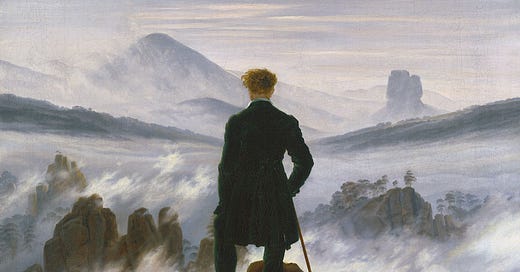This series is inspired by a client. They asked me for resources for starting a spiritual practice and there were no basic, yet deep, non-dogmatic sources to which I could point them.
So I thought I’d make my own. Though my point of view is not without its biases (I have been a practitioner of Zen Buddhism for 10 years, I grew up Christian, I am a white, American woman), my aim is not to impose that on you. Rather, I want you to find your specific version of what connects *you* most deeply to God, Spirit, the Great Mystery— whatever lights you up and reminds you of your indelible interweaving with the whole.
With this series, I will highlight some tools that I consider fundamental to a spiritual practice of any sort, with many different ways to approach it depending on your background and comfort level. This first essay covers what I consider fundamental to the spiritual path: avoiding it or turning away after dipping a toe as well as its antidote: loving, nonjudgmental attention.
The first tenant of the spiritual path: carving out quiet, contemplative space to be open to the divine.
But of course I have plenty more to say on it.
What does it mean to start the spiritual path and what does it look like to continue? Mostly, paying attention.
Refusing the Call
To begin the spiritual practice is a noble task. It is, essentially opening yourself to influence beyond the human and the seen, which is to say, an opening up to a deeper truth than one you can find in your mind or in a book. The spiritual path, like most worth taking, doesn’t form a narrow, clean track. “How do you walk straight on a path with 99 curves?” asks one of my favorite Zen koans. The second we think we’ve reached some clearing in the realm of spirit, it only opens up to more wilderness, more uncharted territory, more unknown horrors and dreams to witness. My teacher described Zen practice as constantly getting the rug pulled out from under you.
The spiritual path is like the night: mysterious, shadowy, full of fears, both real and imagined. We face our ghosts, demons, madwomen in the attic, the harsh truths and memories that we don’t want to see. As we must take all of ourselves on the road, nothing can go unintegrated or examined unless we come out lopsided, still egotistic, warped by our own limitations and failures rather than galvanized by them. There are plenty reasons to flee. Many do. You are allowed your hesitation and refusal. The funny thing about the spiritual path is all must be included, even your denial of it. Another Zen Koan: “Officially not even a needle is admitted; privately even a horse and carriage can pass.”1 The spiritual path is subtle, full of human error and stumbling. But there is also no way you are not on it when you start walking, like when you try and wake up from a dream but then you just wake up in another.
One of my favorite James Hillman passages speaks to this back-and-forth motion. In his book “The Soul’s Code,” which addresses his acorn theory, that each of us come into this world with a specific genius, or daimon, guiding our souls and laying out our purpose, he speaks of an interesting phenomenon. Often, children who grow up to be great and powerful figures run from the very thing that one day catapult’s them to greatness. He tells of Manolete, for example, a famed Spanish matador who was a sickly child initially afraid of bulls. He wonders if his soul knew how strong and fearless he would become so overcompensated comensurate to the dangers it knew he would face.
Perhaps that is why many people avoid the spiritual path until they can’t anymore: they have some intuition as to how big it will be and how much it will require of them. The point is not to judge your reactions at the idea of starting the spiritual path: it’s to be a faithful witness to whatever emotions or thoughts come up. This is the first step: not action, but noticing. It tells the universe that you’re ready to hear it.
Keep reading with a 7-day free trial
Subscribe to Recent Bedroom to keep reading this post and get 7 days of free access to the full post archives.




